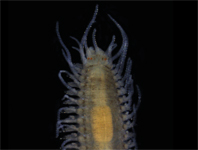Abstract
The pseudoscorpion genus Verrucachernes Chamberlin, 1947 is widely distributed in the Old World tropics, with three named Australasian and West Pacific species and two from Africa. A review of some pseudoscorpions described from India has revealed that Withius parvus Beier, 1930 (currently in the genus Metawithius) and Pselaphochernes indicus Beier, 1974 are misplaced and actually belong to the genus Verrucachernes Chamberlin, 1947, forming the new combinations V. parvus (Beier, 1930) comb. nov. and V. indicus (Beier, 1974) comb. nov., respectively. Both species possess the single, large, rounded spermatheca and other features typical of Verrucachernes.
References
Álvarez-Padilla, F. & Hormiga, G. (2007) A protocol for digesting internal soft tissues and mounting spiders for scanning electron microscopy. Journal of Arachnology, 35, 538–542.
https://doi.org/10.1636/Sh06-55.1
Beier, M. (1930) Die Pseudoskorpione der Sammlung Roewer. Zoologischer Anzeiger, 91, 284–300.
Beier, M. (1932) Pseudoscorpionidea II. Subord. C. Cheliferinea. Tierreich, 58, i–xxi, 1–294.
https://doi.org/10.1515/9783111435114
Beier, M. (1951) Die Pseudoscorpione Indochinas. Mémoires du Muséum National d'Histoire Naturelle, Paris, nouvelle série, 1, 47–123.
Beier, M. (1957) Pseudoscorpionida. Insects of Micronesia, 3, 1–64.
Beier, M. (1959) Pseudoscorpione aus dem Belgischen Congo gesammelt von Herrn N. Leleup. Annales du Musée du Congo Belge, Sciences Zoologiques, 72, 5–69.
Beier, M. (1965) Die Pseudoscorpioniden Neu-Guineas und der benachbarten Inseln. Pacific Insects, 7, 749–796.
Beier, M. (1974) Pseudoscorpione aus Südindien des Naturhistorischen Museums in Genf. Revue Suisse de Zoologie, 81, 999–1017.
https://doi.org/10.5962/bhl.part.76057
Beier, M. (1979) Neue afrikanische Pseudoskorpione aus dem Musée Royal de l'Afrique Central in Tervuren. Revue de Zoologie Africaine, 93, 101–113.
Callaini, G. (1986) Appunti su alcune specie italiane della famiglia Chernetidae Menge (Arachnida, Pseudoscorpionida). Notulae Chernetologicae XV. Bollettino del Museo Civico di Storia Naturale, Verona, 11, 379–401.
Chamberlin, J.C. (1931) The arachnid order Chelonethida. Stanford University Publications, Biological Sciences, 7, 1–284.
Chamberlin, J.C. (1947) Three new species of false scorpions from the islands of Guam (Arachnida, Chelonethida). Occasional Papers of the Bernice P. Bishop Museum, 18, 305–316.
Harvey, M.S. (1988) Pseudoscorpions from the Krakatau Islands and adjacent regions, Indonesia (Chelicerata: Pseudoscorpionida). Memoirs of the Museum of Victoria, 49, 309–353.
https://doi.org/10.24199/j.mmv.1988.49.13
Harvey, M.S. (1992) The phylogeny and classification of the Pseudoscorpionida (Chelicerata: Arachnida). Invertebrate Taxonomy, 6, 1373–1435.
https://doi.org/10.1071/IT9921373
Harvey, M.S. (1995) Barbaraella gen. nov. and Cacoxylus Beier (Pseudoscorpionda: Chernetidae), two remarkable sexually dimorphic pseudoscorpions from Australasia. Records of the Western Australian Museum, Supplement, 52, 199–208.
Harvey, M.S. (2013) Pseudoscorpions of the World, version 3.0. Western Australian Museum, Perth. Available from: http://museum.wa.gov.au/catalogues-beta/pseudoscorpions (Accessed 19 Mar. 2019)
Harvey, M.S. (2015a) A review of the taxonomy and biology of pseudoscorpions of Nannowithius and Termitowithius (Pseudoscorpiones, Withiidae), inquilines of social insects. Journal of Arachnology, 43, 342–352.
https://doi.org/10.1636/arac-43-03-342-352Harvey, M.S. (2015b) Revised diagnoses for the pseudoscorpion genera Metawithius and Microwithius, with the description of a new Australian genus, and notes on Withius (Pseudoscorpiones, Withiidae). Journal of Arachnology, 43, 353–370.
https://doi.org/10.1636/0161-8202-43.3.353Harvey, M.S. & Edward, K.L. (2007) A review of the pseudoscorpion genus Ideoblothrus (Pseudoscorpiones, Syarinidae) from western and northern Australia. Journal of Natural History, 41, 445–472.
https://doi.org/10.1080/00222930701219123
Harvey, M.S., Ratnaweera, P.B., Udagama, P.V. & Wijesinghe, M.R. (2012) A new species of the pseudoscorpion genus Megachernes (Pseudoscorpiones: Chernetidae) associated with a threatened Sri Lankan rainforest rodent, with a review of host associations of Megachernes. Journal of Natural History, 46, 2519–2535.
https://doi.org/10.1080/00222933.2012.707251
Johnson, J., Romero-Ortiz, C., Mathew, A.V., Sebastian, P.A., Joseph, M.M. & Harvey, M.S. (2019) A new species of the pseudoscorpion genus Metawithius from India, with the redescription of Metawithius nepalensis (Pseudoscorpiones: Withiidae). Journal of Arachnology, in press.
Judson, M.L.I. (2007) A new and endangered species of the pseudoscorpion genus Lagynochthonius from a cave in Vietnam, with notes on chelal morphology and the composition of the Tyrannochthoniini (Arachnida, Chelonethi, Chthoniidae). Zootaxa, 1627, 53–68.
https://doi.org/10.11646/zootaxa.1627.1.4
Mahnert, V. (2009) New species of pseudoscorpions (Arachnida, Pseudoscorpiones: Chthoniidae, Chernetidae) from caves in China. Revue Suisse de Zoologie, 116, 185–201.
https://doi.org/10.5962/bhl.part.79492
Muchmore, W.B. (1975) Use of the spermathecae in the taxonomy of chernetid pseudoscorpions. In: Proceedings of the 6th International Arachnological Congress. Vrije Universiteit of Amsterdam, Amsterdam, pp. 17–20.
Muchmore, W.B. (1990) Termitowithius kistneri, a new genus and species of termitophilous pseudoscorpion from Tanzania (Pseudoscorpionida: Withiidae). Bulletin of the British Arachnological Society, 8, 125–127.
Murthy, V.A. & Ananthakrishnan, T.N. (1977) Indian Chelonethi. Oriental Insects Monograph, 4, 1–210.
Nassirkhani, M. (2018) A redescription of Pselaphochernes scorpioides (Hermann) (Pseudoscorpiones; Chernetidae). International Journal of Avian & Wildlife Biology, 3, 240–243.
Redikorzev, V. (1949) [Pseudoscorpionidea of Central Asia]. Travaux de l'Institute de Zoologique de l'Académie Sciences de l'U.R.S.S., 8, 638–668.
Schawaller, W. (1986) Pseudoskorpione aus der Sowjetunion, Teil 2 (Arachnida: Pseudoscorpiones). Stuttgarter Beiträge zur Naturkunde (A), 396, 1–15.
Schawaller, W. (1991) Neue Pseudoskorpion-Funde aus dem Nepal-Himalaya, III (Arachnida: Pseudoscorpiones). Revue Suisse de Zoologie, 98, 769–789.
https://doi.org/10.5962/bhl.part.79812
Schawaller, W. (1994) Pseudoskorpione aus Thailand (Arachnida: Pseudoscorpiones). Revue Suisse de Zoologie, 101, 725–759.
https://doi.org/10.5962/bhl.part.79926
Schawaller, W. (1995) Review of the pseudoscorpion fauna of China (Arachnida: Pseudoscorpionida). Revue Suisse de Zoologie, 102, 1045–1064.
https://doi.org/10.5962/bhl.part.80489
Vachon, M. (1957) Remarques sur les Chernetidae (Pseudoscorpions) de la fauna britannique. Annals and Magazine of Natural History, (12) 10, 389–394.
https://doi.org/10.1080/00222935708655973

